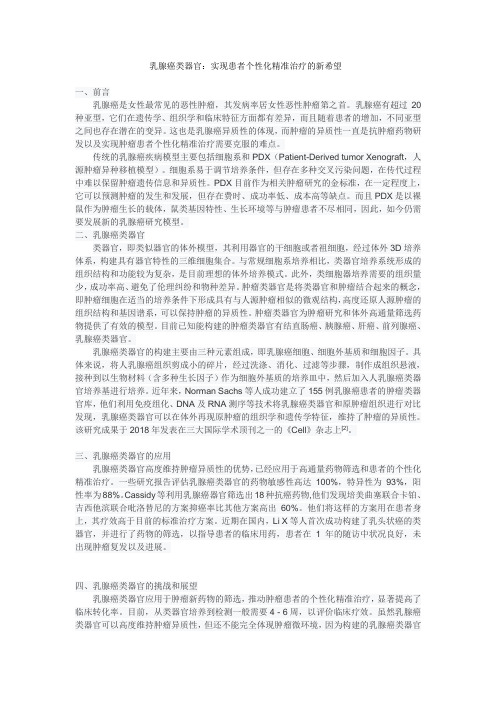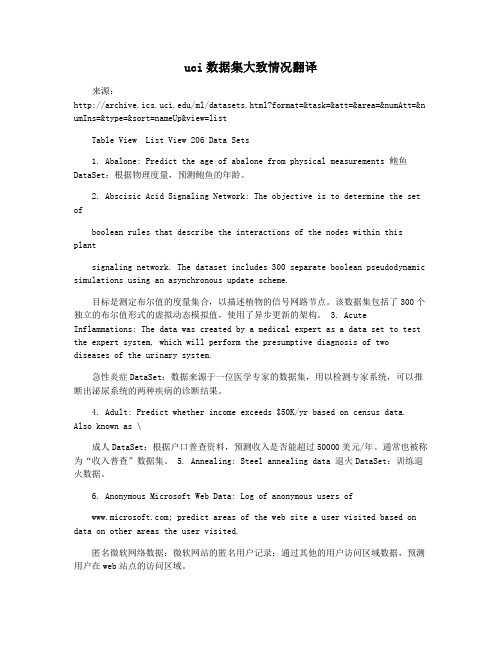A model of breast cancer heterogeneity reveals vascular mimicry as a driver of metastasis
- 格式:pdf
- 大小:3.16 MB
- 文档页数:23


乳腺癌类器官:实现患者个性化精准治疗的新希望一、前言乳腺癌是女性最常见的恶性肿瘤,其发病率居女性恶性肿瘤第之首。
乳腺癌有超过20种亚型,它们在遗传学、组织学和临床特征方面都有差异,而且随着患者的增加,不同亚型之间也存在潜在的变异。
这也是乳腺癌异质性的体现,而肿瘤的异质性一直是抗肿瘤药物研发以及实现肿瘤患者个性化精准治疗需要克服的难点。
传统的乳腺癌疾病模型主要包括细胞系和PDX(Patient-Derived tumor Xenograft,人源肿瘤异种移植模型)。
细胞系易于调节培养条件,但存在多种交叉污染问题,在传代过程中难以保留肿瘤遗传信息和异质性。
PDX目前作为相关肿瘤研究的金标准,在一定程度上,它可以预测肿瘤的发生和发展,但存在费时、成功率低、成本高等缺点。
而且PDX是以裸鼠作为肿瘤生长的载体,鼠类基因特性、生长环境等与肿瘤患者不尽相同,因此,如今仍需要发展新的乳腺癌研究模型。
二、乳腺癌类器官类器官,即类似器官的体外模型,其利用器官的干细胞或者祖细胞,经过体外3D培养体系,构建具有器官特性的三维细胞集合。
与常规细胞系培养相比,类器官培养系统形成的组织结构和功能较为复杂,是目前理想的体外培养模式。
此外,类细胞器培养需要的组织量少,成功率高、避免了伦理纠纷和物种差异。
肿瘤类器官是将类器官和肿瘤结合起来的概念,即肿瘤细胞在适当的培养条件下形成具有与人源肿瘤相似的微观结构,高度还原人源肿瘤的组织结构和基因谱系,可以保持肿瘤的异质性。
肿瘤类器官为肿瘤研究和体外高通量筛选药物提供了有效的模型。
目前已知能构建的肿瘤类器官有结直肠癌、胰腺癌、肝癌、前列腺癌、乳腺癌类器官。
乳腺癌类器官的构建主要由三种元素组成,即乳腺癌细胞、细胞外基质和细胞因子。
具体来说,将人乳腺癌组织剪成小的碎片,经过洗涤、消化、过滤等步骤,制作成组织悬液,接种到以生物材料(含多种生长因子)作为细胞外基质的培养皿中,然后加入人乳腺癌类器官培养基进行培养。

COX2-PGE2调节肿瘤的发生和发展机制研究进展张翅腾;王毅【摘要】前列腺素E2(prostaglandin E2,PGE2)是体内的一种花生四烯酸代谢产物,它与机体的发热、炎症反应和细胞生长及分化等生理活动密切相关.环氧化酶2(Cyclooxygenase 2,COX2)是PGE2合成的主要限速酶,主要在细胞因子、生长因子等促炎症因素作用下产生.近年来的一些研究发现COX2-PGE2信号通路与多种类型的肿瘤细胞的增殖和转移有关,然而,其具体机制尚未完全清楚,目前的研究提示其在不同的肿瘤细胞中可能具有不同的作用机制.针对COX2-PGE2通路调节肿瘤细胞生长的机制的研究对深入了解肿瘤的发生和发展具有重要的意义,并有望为抗肿瘤药物的研发提供一个新靶点.【期刊名称】《西南军医》【年(卷),期】2018(020)001【总页数】4页(P50-53)【关键词】前列腺素E2;肿瘤;环氧合酶2【作者】张翅腾;王毅【作者单位】421000 湖南衡阳,南华大学附属第二医院泌尿外科;421000 湖南衡阳,南华大学附属第二医院泌尿外科【正文语种】中文【中图分类】R73.34恶性肿瘤是21世纪威胁人类健康最重要的因素之一,每年至少有800万人死于恶性肿瘤。
预计在下一个20年内,全球每年新发癌症病例数将由2012年的1400万上升到2200万。
正因如此,恶性肿瘤的发生与治疗也成为了本世纪医学研究最热门的课题之一。
随着肿瘤发病机制研究的深入以及临床治疗方案的不断改进,人类已经在肿瘤的预防和治疗方面取得了很大的进步。
但是目前临床普遍应用的肿瘤治疗方案,包括各类手术切除、放疗和/或化疗等的疗效都在很大程度上依赖肿瘤的早期诊断。
然而,在实际临床工作中,大多数癌症患者就诊时已经处于肿瘤的中晚期,目前所用的常规治疗方案只能维持较短的生存期限(一般小于5年)。
因此,我们迫切的需要进一步明确肿瘤发生及发展的相关机制,并研发出更为有效的抗肿瘤药物。

纹理分析在肿瘤影像组学中的临床应用陈国钰; 沈桂权; 高波【期刊名称】《《贵州医药》》【年(卷),期】2019(043)007【总页数】3页(P1037-1039)【关键词】纹理分析; 影像组学; 肿瘤; 应用【作者】陈国钰; 沈桂权; 高波【作者单位】贵州医科大学附属医院影像科贵州贵阳550004; 烟台毓璜顶医院影像科山东烟台264000【正文语种】中文【中图分类】R445为精确反映整个肿瘤内部的生物学信息,人们使用计算机技术挖掘医学图像中的特征空间数据——影像组学已成为影像学研究的最新目标[1]。
影像组学把全部肿瘤作为研究客体,能全面评估肿瘤内部的异质性等生理情况,取得临床及传统影像学无法获得的信息。
纹理分析(texture analysis,TA)是影像组学中的一部分,是医学图像中近年才发展起来的评价肿瘤异质性的新工具。
1 TA的概念纹理是图像中非常基本且有用的信息特征,也是图像处理分析的重要参考参数。
应用不同的提取方法得到不同的纹理特征,反映不同的生理或病理信息。
对图像进行纹理分析能得到更全面的信息,是行之有效且安全无创的。
2 TA的方法总的来说,纹理分析的方法有三种:统计分析法[2]、模型分析法[3]和变换分析法[4]。
2.1 统计分析法这是研究及使用最多的纹理分析方法,也是最先研究的一种方法,它不像直方图法不能反映空间位置信息。
根据特征计算时使用1个像素、2个像素或者3个及以上像素,把其分为一阶统计量、二阶统计量和高阶统计量。
2.2 模型分析法模型法把图像中的各个像素内部之间看作有着某种函数关系,在整体上估计出全部像素的空间位置关系。
模型法需要先了解图像内部基元的排列结构情况,以便选择合适的模型,再评估模型的相关系数,最后进行纹理特征的提取。
模型分析法是使用复杂数学模型来描述图像中的纹理,它的计算相当复杂,对简单纹理适用,但对于结构复杂的纹理要使用多种模型进行分块评估。
2.3 变换分析法它是在不同的空间分析图像中的纹理特性,比如不同的频率空间或尺度空间。

uci数据集大致情况翻译来源:/ml/datasets.html?format=&task=&att=&area=&numAtt=&n umIns=&type=&sort=nameUp&view=listTable View List View 206 Data Sets1. Abalone: Predict the age of abalone from physical measurements 鲍鱼DataSet:根据物理度量,预测鲍鱼的年龄。
2. Abscisic Acid Signaling Network: The objective is to determine the set ofboolean rules that describe the interactions of the nodes within this plantsignaling network. The dataset includes 300 separate boolean pseudodynamic simulations using an asynchronous update scheme.目标是测定布尔值的度量集合,以描述植物的信号网路节点。
该数据集包括了300个独立的布尔值形式的虚拟动态模拟值,使用了异步更新的架构。
3. Acute Inflammations: The data was created by a medical expert as a data set to test the expert system, which will perform the presumptive diagnosis of two diseases of the urinary system.急性炎症DataSet:数据来源于一位医学专家的数据集,用以检测专家系统,可以推断出泌尿系统的两种疾病的诊断结果。

浅谈乳腺癌HER2异质性自人类表皮生长因子受体2(HER2)被确定为乳腺癌的治疗靶点以来,随后开发出一系列抗HER2靶向疗法,可以说彻底改变了HER2阳性乳腺癌的治疗局面。
然而,肿瘤中频繁可见的HER2低表达或异质性表达正在被逐渐关注。
不同的HER2表达会影响到传统抗HER2靶向治疗的获益程度,而随着新型ADC药物的出现,使得HER2低表达乳腺癌同样成为抗HE R2靶向治疗获益人群。
同时许多研究报道了HER2异质性的存在与较短的无病生存期(DFS)和总生存期(OS)之间的相关性。
临床上需要对能够识别HER2异质性的技术进行更多验证,并开发有效治疗HE R2表达不均匀的抗肿瘤药物。
一篇题为《Targeting HER2 heteroge neity in breast cancer》的研究报道对相关内容进行了阐述[1],本文对其重点内容进行了梳理。
HER2异质性概述HER2在20世纪80年代中期被确定为一种刺激肿瘤生长的致癌基因。
HER2是一个跨膜的酪氨酸激酶(TK)受体,与HER受体家族的另一个成员EGFR(HER1)形成活跃的二聚体。
随后受体上酪氨酸残基的磷酸化导致细胞内信号通路的激活,促进细胞生长和增殖。
H ER2在大约20%-25%的乳腺癌中过表达[2],这种过表达主要是基因扩增的结果,并且HER2过表达提示乳腺癌患者预后较差[3]。
HER2过表达和预后不良之间的关系促使人们寻找能抑制HER2活性的方法,由此激发了诸如单克隆抗体、酪氨酸激酶抑制剂、ADC药物等的开发。
这些抗HER2疗法的疗效在通过免疫组化(IHC)检测H ER2过表达(3+)或通过荧光原位杂交(FISH)检测HER2基因扩增的乳腺癌中最为明显。
多年来,HER2检测方法已经得到了标准化,具体的检测标准也已得到建立和不断更新。
随着新型ADC药物的发展,最近的研究已经转向探索HER2低表达乳腺癌患者对HER2靶向ADC疗法的应答。
Breast cancer is a significant health concern affecting millions of women worldwide, and it is essential to understand its causes,symptoms,and treatment options to combat this disease effectively.1.Causes of Breast Cancer:The exact cause of breast cancer is not fully understood,but it is believed to be influenced by a combination of genetic and environmental factors. Genetic predisposition,such as mutations in the BRCA1and BRCA2genes,can increase the risk of developing breast cancer.Additionally,lifestyle factors such as obesity, alcohol consumption,and exposure to certain chemicals may also play a role.2.Symptoms of Breast Cancer:Early detection is crucial for successful treatment.Some common symptoms include a lump or thickening in the breast or armpit,changes in the size or shape of the breast,dimpling of the skin,or discharge from the nipple.It is important for women to perform regular selfexaminations and to consult a healthcare professional if they notice any unusual changes.3.Diagnosis:If a woman or her healthcare provider suspects breast cancer,diagnostic tests such as mammograms,ultrasounds,or magnetic resonance imaging MRI may be performed.A biopsy,where a small sample of tissue is taken for examination,is often the definitive way to confirm a diagnosis.4.Treatment Options:Treatment for breast cancer can vary depending on the stage of the cancer,the patients overall health,and personal mon treatments include surgery to remove the tumor,radiation therapy to kill cancer cells,chemotherapy to destroy cancer cells throughout the body,hormone therapy to block hormones that can promote cancer growth,and targeted therapy to attack specific characteristics of cancer cells.5.Prevention and Risk Reduction:While not all cases of breast cancer can be prevented, there are steps that can be taken to reduce the risk.These include maintaining a healthy weight,engaging in regular physical activity,limiting alcohol intake,and avoiding exposure to certain environmental carcinogens.6.Importance of Research:Ongoing research is vital for improving our understanding of breast cancer,developing new treatments,and finding ways to prevent the disease. Support for research can come in many forms,from funding to advocacy and raising awareness.7.Support for Patients:Living with a breast cancer diagnosis can be challenging both physically and emotionally.Support groups,counseling,and educational resources canprovide valuable assistance to patients and their families.8.Global Impact:Breast cancer is a global issue,affecting women in both developed and developing countries.Efforts to address disparities in access to care and treatment are essential to reducing the global burden of this disease.9.Advocacy and Awareness:Raising awareness about breast cancer through events like Breast Cancer Awareness Month can help educate the public,promote early detection, and encourage support for research and treatment initiatives.10.Personal Stories:The experiences of breast cancer survivors can provide inspiration and insight into the challenges and triumphs associated with the disease.Sharing these stories can help to humanize the issue and motivate others to take action. Understanding breast cancer is the first step towards fighting it.By being informed about the disease,individuals can make better decisions about their health and contribute to the global effort to reduce the impact of breast cancer.。
我的心愿希望科学家发明新药治愈癌症英语作文Cancer has long been one of the most formidable adversaries in the field of medicine. Its pervasive nature, with the ability to affect virtually any part of the human body, and its complex mechanisms of progression and resistance to treatment, make it a particularly challenging disease to combat. The desire for a cure is universal, transcending borders, cultures, and socioeconomic statuses. As such, the hope that scientists will one day develop a new drug capable of curing cancer is a profound and pervasive aspiration that drives much of contemporary biomedical research.The scientific community has made significant strides in understanding the biology of cancer. The discovery of oncogenes and tumor suppressor genes has elucidated some ofthe genetic foundations of cancer. Researchers have identified pathways and molecular mechanisms that drive the uncontrolled growth of cancer cells. These advances have paved the way for targeted therapies, which are designed to specifically inhibit the function of molecules critical for cancer cell survival and proliferation. Drugs like Imatinib (Gleevec) for chronic myeloid leukemia and Trastuzumab (Herceptin) for HER2-positive breast cancer are prime examples of how understanding cancer at the molecular level can lead to effective treatments.However, despite these advances, the quest for a universal cure for cancer remains elusive. One of the significant challenges in developing a cure is the heterogeneity of cancer. Each type of cancer, and even each patient's cancer, can have a unique genetic and molecular profile. This heterogeneity makes it difficult to develop a one-size-fits-all treatment. Moreover, cancer cells canevolve and develop resistance to treatments, rendering many drugs ineffective over time.Immunotherapy has emerged as a promising approach in the fight against cancer. By harnessing the body's immune system to recognize and destroy cancer cells, immunotherapy offers a different angle of attack compared to traditional treatments like chemotherapy and radiation. Drugs such as Pembrolizumab (Keytruda) and Nivolumab (Opdivo) have shown remarkable success in treating certain cancers by targeting immune checkpoints, proteins that normally help keep immune responses in check but are exploited by cancer cells to avoid being attacked by the immune system. The development of CART-cell therapy, where a patient's T cells are genetically modified to target cancer cells, has also shown promising results, particularly in blood cancers like leukemia and lymphoma.Another exciting area of research is the development of personalized medicine. By analyzing a patient's genetic makeup and the specific characteristics of their cancer, scientists can tailor treatments that are more effective and have fewer side effects. This approach not only improves the efficacy of treatment but also helps in minimizing the adverse effects associated with conventional therapies. Personalized medicine is already being implemented in some areas of cancer treatment, and continued advancements in genomic sequencing and bioinformatics are likely to expandits applicability.In addition to these biological and technological advancements, the role of early detection and prevention cannot be overstated. Early detection of cancer significantly increases the chances of successful treatment and survival. Techniques such as liquid biopsies, which detect cancer-related genetic mutations and proteins in blood samples, are becoming more refined and could revolutionize cancerscreening and diagnosis. Preventative measures, including lifestyle modifications and vaccinations, such as the HPV vaccine to prevent cervical cancer, also play a crucial role in reducing cancer incidence.While the scientific and medical communities continue to make progress, it is important to recognize the broadersocial and economic factors that impact the fight against cancer. Access to healthcare, affordability of treatments, and disparities in healthcare quality are significant issues that need to be addressed to ensure that advancements in cancer treatment benefit all segments of society. Moreover, the psychological and emotional support for cancer patients and their families is a critical component of comprehensive cancer care.The quest for a cure for cancer is not just a scientific challenge but a human one. It requires the collective efforts of researchers, clinicians, policymakers, patients, andadvocates. Continued investment in cancer research, support for innovative and interdisciplinary approaches, and a commitment to equitable healthcare access are essential to make the dream of curing cancer a reality.In conclusion, the hope that scientists will one day develop a new drug capable of curing cancer is a powerful and motivating force. While significant challenges remain, the advancements in our understanding of cancer biology, the development of targeted therapies and immunotherapies, and the promise of personalized medicine provide a strong foundation for optimism. The journey towards a cure is ongoing, and with continued dedication and collaboration, the dream of a world without cancer may one day be realized.。
a case of breast cancerThis case involved a 35-year-old woman who had noticed a small nodule under the skin of the left breast.女性35岁,无意中发现左测乳腺下一小结节。
On clinical examination, a hard lump measuring 0.7×0.6 cm was palpated in the upper outer quadrant of her left breast and also elastic soft induration approximately 5×4 cm was palpated in the outer quadrant of her ipsilateral breast.临床查体中在她的左乳外上象限可触及一硬块约0.7*0.6cm,同侧乳房外象限可触及一5*4cm的软结节。
Axillary lymphadenopathy was absent.同时有腋窝淋巴结肿大。
Mammography showed focal asymmetric density (FAD) in the outer portion of the left breast and an irregular small mass at the outside of FAD.X线表现为局灶性不对称的密度影(FAD),及外侧不规则小肿块密度影。
Ultrasonography demonstrated an irregular hypoechoic mass measuring 0.6×0.6×0.4 cm and a low-echoic area measuring 5×5×1 cm including multiple small cysts inside the small mass .超声显示为不规则的低回声肿块,大小约0.6×0.6×0.4cm,低回声区约为5×5×1cm包括多个小囊肿内的小肿块。